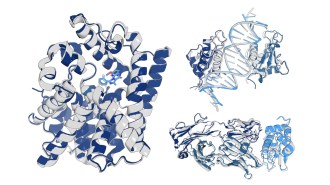- More than 2 years ago
Taking a step toward the creation of molecule-scale motors for equally tiny tasks, researchers have made rings of organic molecules on which one or two smaller chemical rings rotate like charms on a bracelet. In the version with two small rings, the scientists can control the direction of the rings’ rotation.
David A. Leigh of the University of Edinburgh and his colleagues synthesized the interlocking rings in solutions. Each large ring contains three or four different chemical groups, or stations, where the small rings are temporarily held in place by hydrogen bonding. In the July 10 Nature, Leigh and his coworkers report that they can control the small rings’ attraction to these stations using light, heat, or chemicals.
In rotors with just one small ring–a molecular system called a [2]catenane–the researchers can direct the small ring to the station they choose. However, the team can’t designate which direction the small ring will travel around the big ring.
In a rotor with two small rings, called a [3]catenane, each small ring blocks the other’s movement backward on the big ring. The small rings therefore always move in the same direction.
Many researchers are aiming to create molecular motors that can operate, for example, tiny valves, switches, pumps, and other parts in drug-delivery systems or in computer-chip-size laboratories (SN: 11/9/02, p. 291: Available to subscribers at Nanotech Switch: Strategy controls minuscule motor). The new catenane structures could be used to make surfaces that change color, stickiness, and other properties depending on the relative positions of the rings, suggests Leigh.
****************
If you have a comment on this article that you would like considered for publication in Science News, send it to editors@sciencenews.org. Please include your name and location.






